“Exodus” from Puerto Rico, A Visual Guide
‘Exodus’ from
Puerto Rico: A Visual Guide
Hurricane Maria sent thousands
fleeing devastation in Puerto Rico.
Federal data obtained by CNN suggest
migrants have moved to every US state –
even Alaska.
By John D. Sutter and Sergio Hernandez
CNN (February 21, 2018)
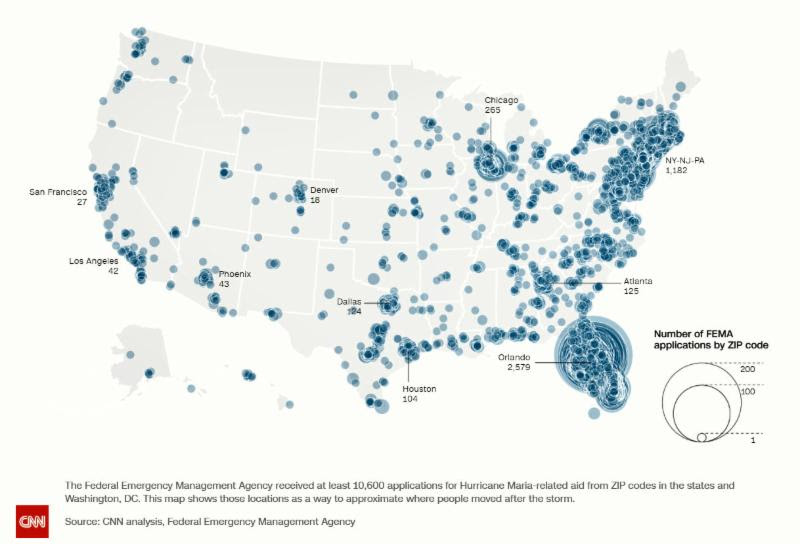
Before Hurricane Maria hit Puerto Rico on September 20, there already was an unprecedented migration from the Caribbean island to the mainland United States — at least in part because of the US commonwealth’s financial crisis. After the storm, academics are starting to use words such as “exodus” and “stampede” to describe the massive outflow of people.
“This is the greatest migration ever from Puerto Rico since records have been taken,” said Jorge Duany, a professor of anthropology at Florida International University.
Some reasons for the migration are obvious: Millions of Americans living in Puerto Rico were left without power or running water because of the Category 4 hurricane. Schools were closed. Jobs lost. There seemed to be little hope on the horizon. Puerto Ricans are American citizens and can move to the states without visas or other paperwork. And so, many did.
Yet the scope and shape of this diaspora remain mysterious.
So far, estimates of its size have been based on airline traveler data, which some academics consider unreliable because flying off the island doesn’t necessarily mean you’re going to migrate. Florida school enrollment numbers have added clarity, but they only cover students who showed up in the Sunshine State, not the entire nation.
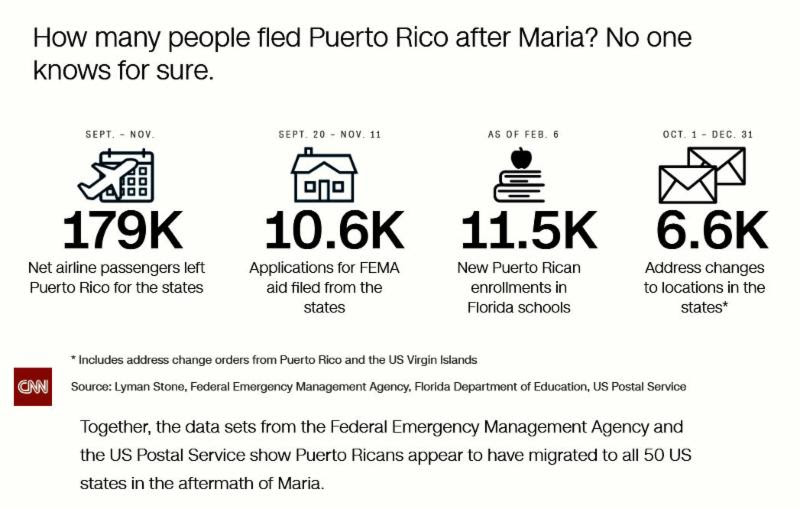
To get a clearer picture of the migration patterns, CNN analyzed data from two federal government agencies obtained under the US Freedom of Information Act.
Together, the data sets from the Federal Emergency Management Agency and the US Postal Service show Puerto Ricans appear to have migrated to all 50 US states in the aftermath of Maria.
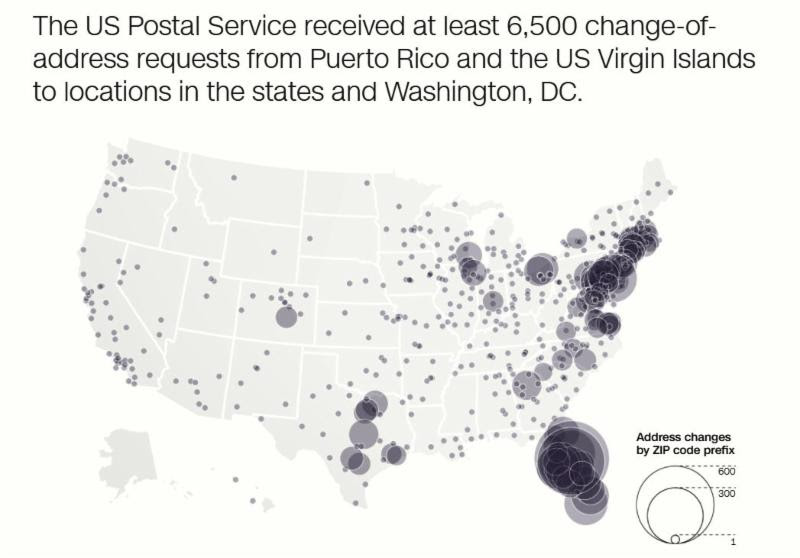
As of November 11, FEMA received at least 10,600 applications for disaster assistance from ZIP codes in 50 states and Washington, according to FEMA data provided to CNN.
The applications may represent households, not individual people. The average Puerto Rican household is made up of about three people, according to the US Census Bureau.
In total, FEMA received more than 1 million applications for aid related to Hurricane Maria in Puerto Rico — indicating nearly everyone who asked FEMA for help under its Individual Assistance programs did not leave the island after the storm.
Still, the data appear to show a substantial increase in the outflow of people from Puerto Rico.
“It sounds possible that we’re on pace for a historic net outmigration to the US” from Puerto Rico, said Jens Manuel Krogstad, an editor at the Pew Research Center. “In 2015, the net outmigration was about 64,000 people. And so, from the numbers you described, it sounds like it’s possible that even after just a few months we’re already on pace to overshoot that.”
Separately, between October 1 and December 31, the US Postal Service received at least 6,590 change-of-address requests — nearly five times the amount received during the same months the previous year — from Puerto Rico and the US Virgin Islands to the 50 states and District of Columbia. The Postal Service received about 2,900 additional requests to change addresses within Puerto Rico, according to the data, suggesting that while some people left Puerto Rico, others moved within the storm-battered island.
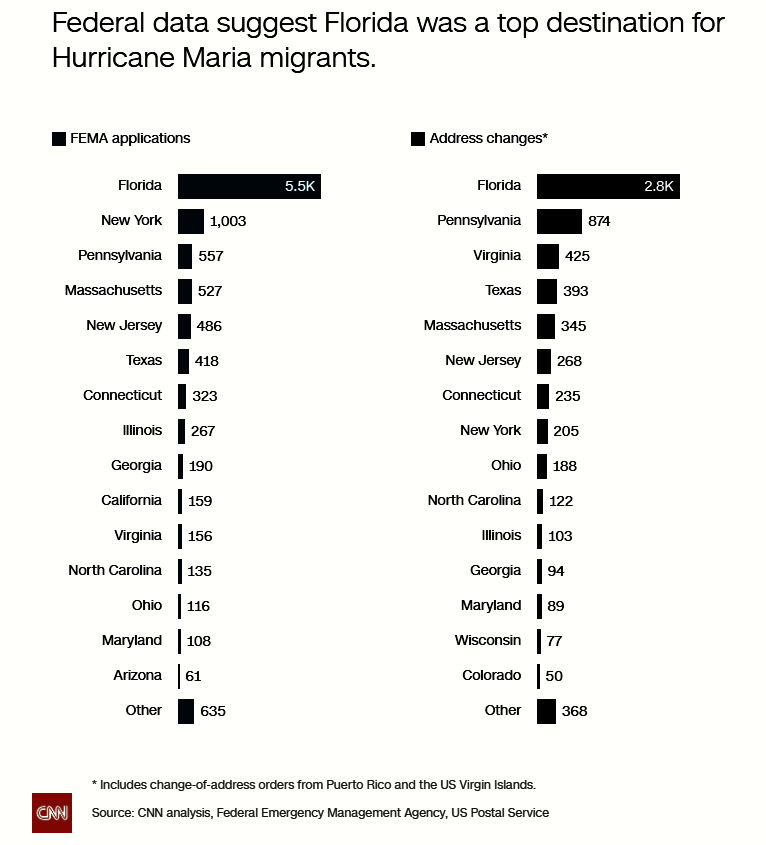
Neither data source is a precise measurement of hurricane-related migration. It’s possible that some people changed their addresses for reasons unrelated to Hurricane Maria. FEMA applicants could have listed current addresses in the states for reasons other than migration. They may have listed a relative’s address in the states even if they did not move away from Puerto Rico, a FEMA representative said.
Several demographers and disaster experts said these methods of counting — tracking disaster-assistance claims and official changes of address — may substantially undercount the true number of people who fled Puerto Rico after Hurricane Maria.
That’s because not everyone who leaves Puerto Rico also files a disaster claim with FEMA, and of those who did file and also moved, some may have listed the address of a relative or friend rather than their new location, said Alexis Santos, a Penn State University demographer who grew up in Puerto Rico. Others may move away from the island without knowing exactly where they will land, he said, making it difficult to track relocations based on this paperwork.
Further, people in Puerto Rico are disinclined to use change-of-address forms — even in normal circumstances, Santos said. He finds it especially unlikely that everyone who moved in the frantic aftermath of Hurricane Maria took the time to file those requests.
“That process — we normally don’t do it,” he said. “We use our mom’s address or something. Still, my uncles receive letters at my grandmother’s house.”
“I don’t know how representative that is of everyone who’s left,” William H. Frey, a senior fellow at the Brookings Institution who studied the Hurricane Katrina diaspora, said of the findings. More interesting, he said, is what the data say about where people are going.
Among the surprises: Migrants appear to have moved to every US state.
FEMA applicants listed current ZIP codes in 48 states — including 11 households in Hawaii, seven in Alaska, three in each of the Dakotas and two in Wyoming.
US Postal Service data suggest people moved after the storm to at least 49 states — all but Alaska — plus Washington, D.C., the US Virgin Islands and the Northern Mariana Islands.

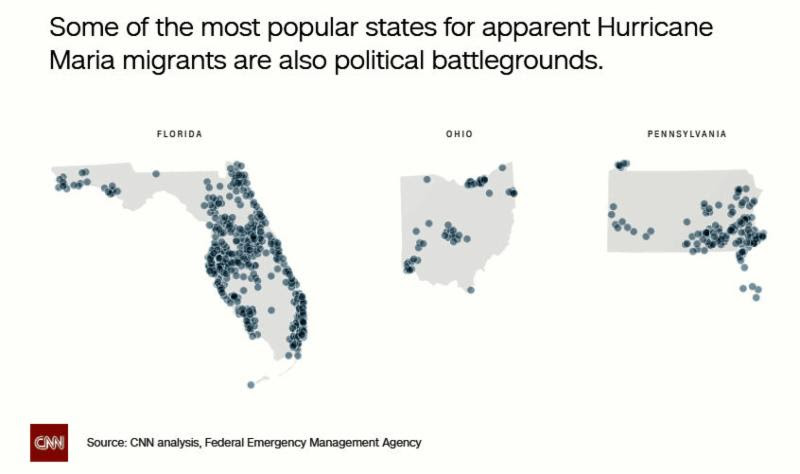
“There are people going to South Dakota to work on farms and turkey factories,” said Edwin Meléndez, a professor of urban affairs and planning at Hunter College in New York and director of the Center for Puerto Rican Studies. Migrants primarily follow the patterns family members and friends have set before them, he said, but they also seek out steady jobs wherever they might be available.
“People are looking for any kind of job they can get,” said the Pew Research Center’s Krogstad. “And if (the job is) in Alaska, they’re willing to give it a shot.
“That happens a lot with migration,” he continued. “It’s what happened a lot over the past 25 years with migration to the Midwest (United States) from Latin America — people moving to small towns that previously had not seen much demographic diversity.”
Florida appears to be the top destination for Maria migrants — by far.
More than half — 52% — of households that filed claims with FEMA from the states did so from Florida, which is the closest state to Puerto Rico geographically and has been the top destination for Puerto Ricans in recent years.
Outside Puerto Rico, the top six counties for FEMA claims — Orange, Osceola, Miami-Dade, Broward, Hillsborough and Polk counties — all are in Florida, according to the FEMA data. Orlando-Kissimmee-Sanford — a metro area in central Florida already known as a mecca for Puerto Ricans — is the top metro area for applicants outside Puerto Rico.
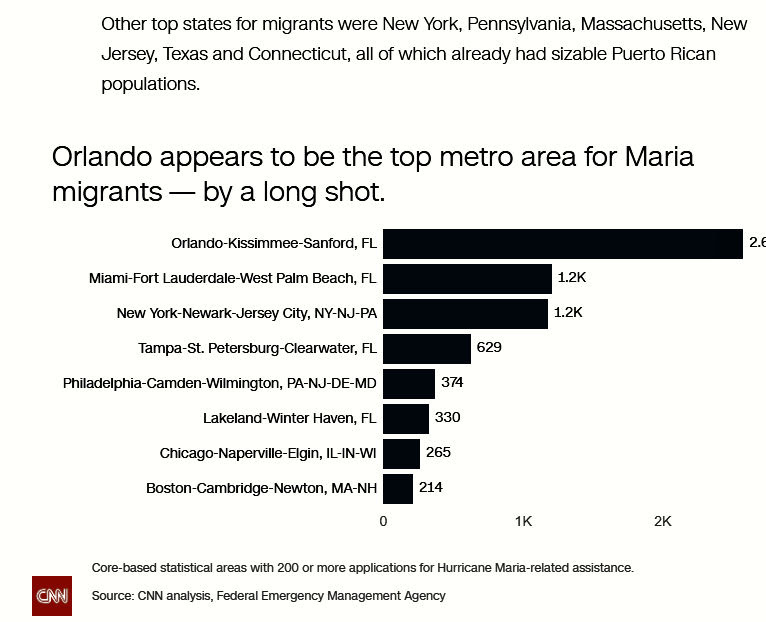
Other top states for migrants were New York, Pennsylvania, Massachusetts, New Jersey, Texas and Connecticut, all of which already had sizable Puerto Rican populations.
US Postal Service data tell a similar story, with about 40% of address change requests from Puerto Rico and the US Virgin Islands listing new ZIP codes in Florida. Other top locations for these requests, which include mail-forwarding requests as well as actual change-of-address orders, included Pennsylvania, Virginia, Texas and Massachusetts, followed by the US Virgin Islands.
It is logical that hurricane victims would move to locations where large numbers of Puerto Ricans already are established, demographers and academics said.
“I would imagine that a lot of people were already thinking about leaving Puerto Rico and this was the final blow,” said Carlos A. Suárez Carrasquillo, a lecturer in political science at the University of Florida. “I am sure that in some cases people were desperate and either left with the humanitarian flights that happened initially or were able to amass money to leave.”
What does all of this mean for US politics?
Puerto Ricans tend to vote left of center, and many have expressed outrage at the way the Republican White House has handled the federal response to the disaster. And while, yes, Puerto Ricans are American citizens even in the Caribbean, they can’t vote for president or elect voting members of the US Congress unless they establish residency in the states.
Florida has become a particular focus of attention since it has welcomed so many migrants. Gov. Rick Scott in October declared a state of emergency because so many people were arriving. Florida schools have seen more than 11,500 new students from Puerto Rico since Hurricane Maria hit, according to data provided by the Florida Department of Education on February 6.
Still, there remains too little information to argue that Maria migrants will sway elections, said Daniel Smith, a professor of political science at the University of Florida.
“I have to wait and see,” Smith said. “Certainly, one could look at analogous situations (like) the displacement of folks following Katrina in New Orleans. I don’t think the lesson we learned from that is that those who were displaced — or who stayed home — became more politically active. I haven’t ever seen any evidence of that. … If not, why are we assuming some supra political participation among the migrants of Puerto Rico to the mainland? There is certainly, in many people’s eyes, good reason for them to become politically engaged and mobilized and to have a clear vote choice. But I’m a realist and I know there are many barriers to participation.”
Among them: These are disaster victims we’re talking about, said Suárez, the University of Florida political scientist who also is Puerto Rican. “If they were traumatized by the experience of the hurricane, the last thing they (may) want to do is think about politics.”
The other question is how long people will stay put.
Lori Peek, director of the Natural Hazards Center at the University of Colorado Boulder, followed migrants for years after Hurricane Katrina hit the US Gulf Coast in 2005. People moved several, if not a dozen, times, she said. Some returned home.
“It was unbelievable, and at times almost unbearable to the heart and mind, to track that amount of displacement in such a short period of time” after Katrina, she said. “One moment — one point on a map at a singular time — doesn’t actually at all tell the story of what displacement means, especially for the most low-income and disadvantaged people. They’re oftentimes living very mobile and very uncertain lives, and when you throw a disaster in, everything is in play. And everything is in transition for such a long period of time.”
Some academics said they find the focus on US politics to be somewhat myopic given the context of what’s happening to more than 3 million people still living in Puerto Rico.
“What will happen to them?” said Pew’s Krogstad. “Even before the storm, Puerto Ricans on the island significantly lagged Puerto Ricans on the mainland on a variety of economic measures — like child poverty and median household income.
“The concern is that these gaps are going to grow even wider.”
“To be frank,” said Suárez, “not only is it self-serving, but it also fails to reflect the desperate conditions and the grating inequality under which the people on the island of Puerto Rico live. That aspect gets lost. This is a place where people are the most desperate.”
Demographic shifts may only make the situation worse.
The island population has been declining since 2004, at least partly because of Puerto Rico’s debt crisis and, more recently, government bankruptcy. All signs pointed to continued population decline, even before Hurricane Maria, according to demographers. The consequences for Puerto Rico could be stark. The population is aging. Maria may help sap the island of vital workers. That could further stall the economy, leading to decreased tax revenue and government services.

“You’re losing people and you’re in an economic depression,” said Meléndez of the Center for Puerto Rican Studies. “The people are what keep businesses open — restaurants and policemen and all of that. So to the extent that the population is declining, you have a problem with economic recovery.”
No US states are shrinking in the way that Puerto Rico is, Krogstad said. “If you compare Puerto Rico to other US states, there really isn’t any comparison.”
“Puerto Rico has seen a net decline of 500,000 people to the US mainland over the past decade or so,” he added. “These are huge shifts. We haven’t seen migration (out of Puerto Rico) of this scale since the World War II era.”
Before the hurricane, this alarmed demographers.
Now, doomsday scenarios aren’t all so difficult to imagine.
Lyman Stone, an economist working with the Puerto Rican Financial Oversight and Management Board to develop population projections, said his early analysis of airline data from the US Department of Transportation shows 179,000 net airline travelers left Puerto Rican airports for the states between September and November.
Stone estimates the island’s population will continue to shrink. If the island rebounds relatively quickly from Hurricane Maria — which he terms a “weak Maria” effect — then perhaps the population will stay closer to 3 million in the next decade. If problems on the island snowball, pushing more people out — which he terms a “strong Maria” effect — Stone estimates Puerto Rico’s population could plunge below 2 million by 2040.
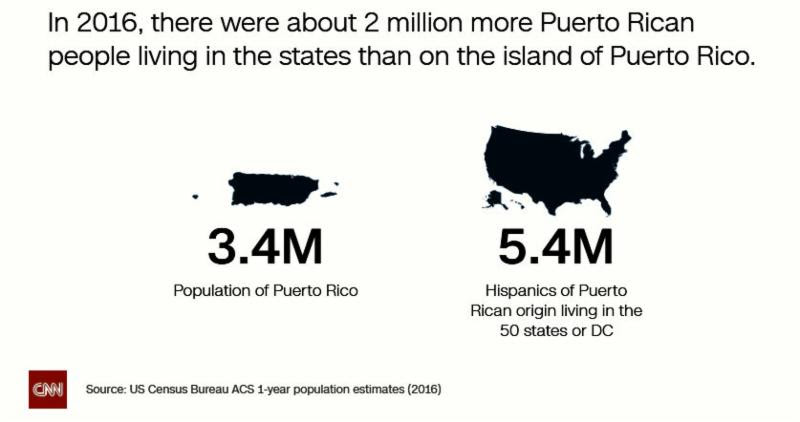
These are rough estimates, he said, but the trend is clear.
“In 10 years, Puerto Rico will have less than 3 million people and still be headed quickly towards 2.5 million or lower,” he said. “Once below that level, I don’t think it will come back above 2.5 million — effectively ever.”
Beyond that, Stone said, only questions remain: Will another hurricane hit? Will Congress provide enough money to help rebuild? Will people return to Puerto Rico — or will more flee?
Time will tell.
CNN’s Curt Merrill contributed to this report. Additional graphics by India Hayes and Sean O’Key.

